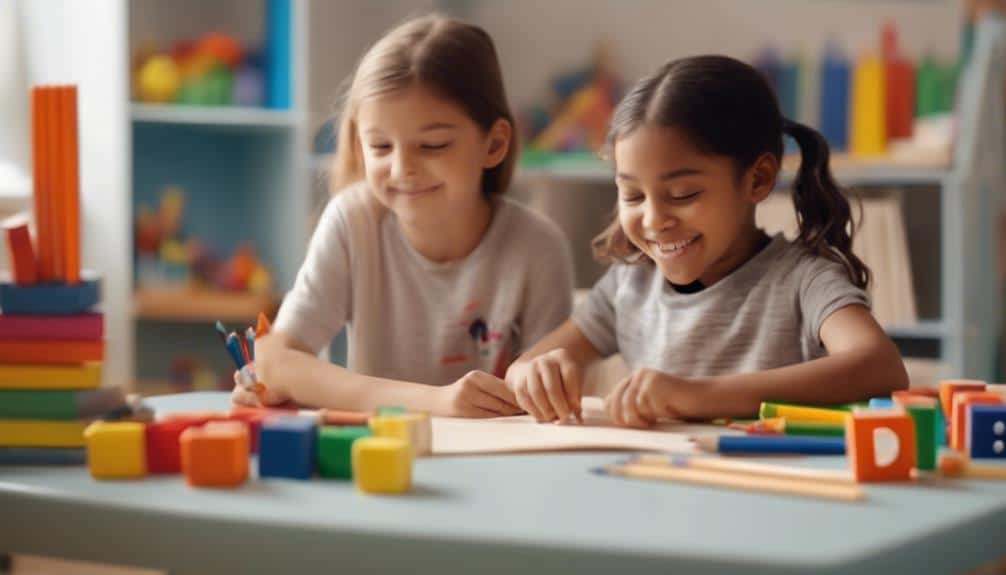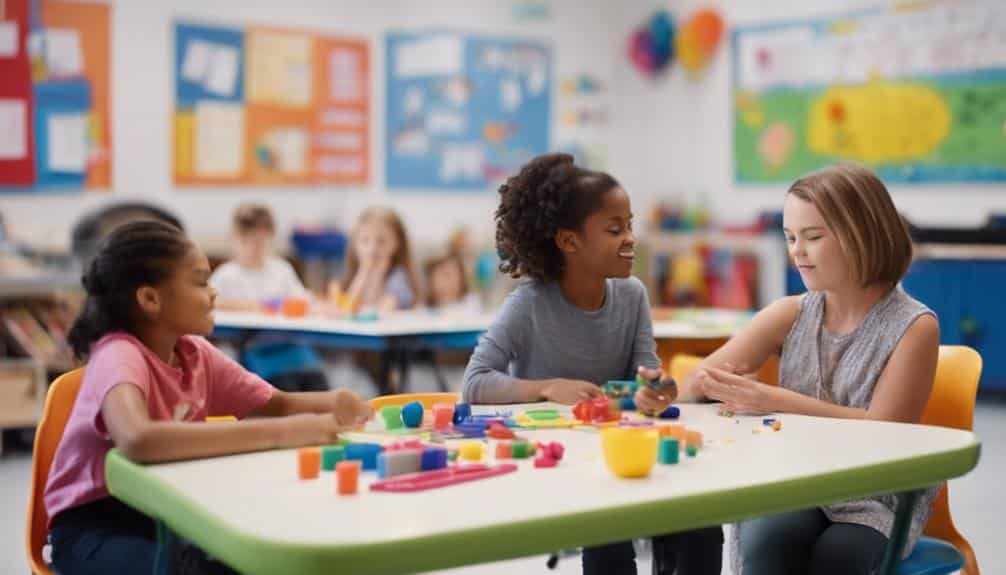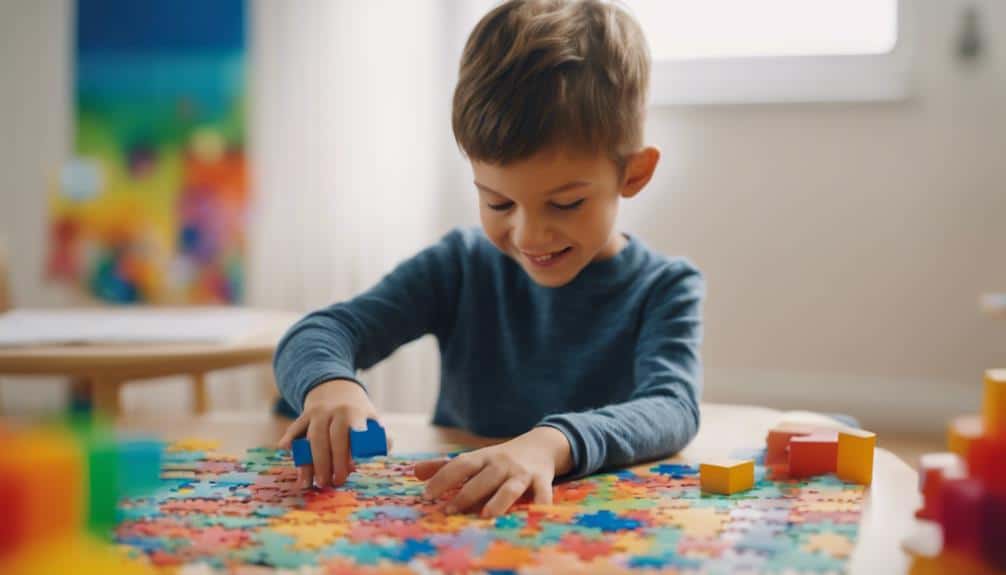Academic Success with Pediatric OT is about looking at the big picture and understanding this therapy’s critical role for sixth-grade kids. Occupational therapy experts carefully use activities that improve how kids use their senses, think, and move to create unique plans for each child. These plans are not just about school grades; they also help kids make friends, handle emotions, and become independent learners.
Understanding how these plans work at school and home makes us think about how much they can help kids in their school journey and their overall happiness and growth. So, ensuring kids do well in school with pediatric OT is like putting together a puzzle that includes not just school stuff but everything that helps a child grow and learn.
Key Takeaways
- Pediatric OT tailors strategies to enhance children’s attention, focus, and sensory processing, which are vital for academic success.
- Creative activities and specialized interventions in OT improve literacy and writing skills, fostering better academic performance.
- Sensory integration techniques and personalized sensory strategies implemented through OT support better classroom learning and participation.
- Collaborative efforts with families in pediatric OT ensure the development of effective, home-based academic support practices.
Understanding Pediatric OT
Pediatric occupational therapy (OT) is crucial in assisting children with developmental or physical disabilities, focusing on overcoming challenges to achieve academic and social success. This specialized field collaborates closely with children and their families to identify specific needs, creating tailored treatment plans that address individual challenges. By employing strategies such as sensory integration, pediatric OT seeks to enhance a child’s ability to process and respond to sensory information. This, in turn, lays a foundation for improved attention span and academic performance, crucial components for success in both school and social settings.
Pediatric occupational therapy aims beyond mere academic achievements; it strives to equip children with the essential skills needed for daily living tasks, following directions, and fostering independence and productivity. Sensory integration techniques, a cornerstone of pediatric OT, play a significant role in this process. Children learn to navigate their sensory experiences more effectively through carefully designed activities, leading to better concentration and engagement in learning environments. By addressing these foundational aspects, pediatric occupational therapy offers children the tools to thrive academically and socially, emphasizing a holistic approach to development and learning.
Attention Improvement Strategies
How can attention improvement strategies, integral to pediatric occupational therapy, be optimized to bolster a child’s academic performance and overall development? Sensory integration techniques stand at the forefront of this endeavor by meticulously regulating sensory input, thus fostering an environment conducive to sustained attention. Such strategies are pivotal, as they lay the foundation for children to navigate academic challenges with increased focus and resilience.
Incorporating cognitive principles into pediatric occupational therapy offers another robust avenue for enhancing attention. These principles aim to sharpen focus and improve children’s ability to complete tasks, directly influencing their academic and developmental milestones. Furthermore, play-based interventions have proven exceptionally effective. These interventions not only engage children in activities that demand concentration but also do so in a manner that is both enjoyable and educational.
Parent education emerges as a critical component in this holistic approach. By equipping parents with the knowledge and tools to support attention improvement strategies at home, the benefits observed during therapy sessions are extended and reinforced in the child’s everyday environment. Tailoring treatment plans to address specific attention challenges ensures that each child receives the most appropriate and practical support, paving the way for their academic success and overall development.
Enhancing Literacy Skills

As we transition from focusing on attention improvement strategies to enhancing literacy skills in pediatric occupational therapy, it’s crucial to address overcoming reading challenges and strengthening writing abilities. Embedded creative activities and interventions recommended by occupational therapists foster a positive attitude towards reading and pave the way for significant improvements in writing skills. We can significantly boost literacy skills through parent-mediated interventions, peer-supported programs, and engaging activities, thereby supporting children’s academic success and overall learning outcomes.
Overcoming Reading Challenges
Overcoming reading challenges in children involves leveraging innovative strategies that enhance literacy skills and boost their confidence and interest in reading. Through pediatric occupational therapy sessions, children engage in various literacy activities crucial for nurturing positive reading attitudes and improving reading skills.
| Strategy | Benefit |
|---|---|
| Creative literacy activities | Improves attitudes toward reading and self-concept |
| Parent-mediated interventions | Increases reading frequency and improves scores |
| Peer-supported reading programs | Enhances reading attitudes and skills |
| Embedded literacy activities | Promotes literacy engagement and participation |
| Literacy participation interventions | Enhances reading skills, motivation, and engagement |
These approaches underscore the importance of a supportive environment in overcoming reading challenges, making reading a more enjoyable and successful experience for children.
Strengthening Writing Abilities
Pediatric occupational therapy is crucial in enhancing children’s literacy skills by strengthening their writing abilities, including improving handwriting legibility and speed. Occupational therapy interventions are designed with a comprehensive approach that addresses various facets of writing, from the physical act of handwriting to the cognitive processes behind it. Handwriting interventions are particularly noteworthy for their focus on sensory processing issues, which can significantly impact a child’s ability to maintain focus and attention during writing tasks. These interventions have been shown to effectively enhance writing abilities by incorporating therapeutic practice approaches, leading to improved academic performance. Moreover, parent-mediated interventions have been found to further encourage reading and writing activities at home, thereby boosting children’s overall literacy engagement and success.
Mastering Handwriting Techniques
Mastering handwriting techniques is a critical step in pediatric occupational therapy, aiming to boost the legibility and speed of a child’s writing, thereby paving the way for academic success and efficiency in daily tasks. Occupational therapists employ various strategies to enhance handwriting skills, recognizing their fundamental role in a child’s educational and daily life. Therapists address each child’s unique challenges through personalized interventions, utilizing evidence-based practices to ensure the most effective outcomes.
- Ergonomically Designed Writing Tools: Special pens and pencils that encourage proper grip and reduce strain.
- Customized Practice Worksheets: Tailored letter formation, alignment, and spacing exercises.
- Sensory Integration Techniques: Activities that improve fine motor skills and hand-eye coordination, essential for writing.
- Feedback and Positive Reinforcement: Continuous assessment and encouragement to motivate children and build confidence in their abilities.
These interventions underscore the importance of developing proficient handwriting techniques through pediatric occupational therapy. By addressing individual needs and leveraging specialized tools and methods, occupational therapists play a pivotal role in fostering academic success and daily functionality, ensuring every child has the tools to thrive in their educational journey and beyond.
Navigating Sensory Processing

Navigating sensory processing is crucial for children who face challenges in interpreting and responding to environmental stimuli, impacting their academic performance and daily life. Understanding sensory overload and implementing targeted sensory strategies can empower these children to regulate their responses better. Through occupational therapy, personalized sensory integration techniques and modulation strategies are applied to enhance a child’s ability to focus, behave appropriately, and participate more fully in academic activities.
Understanding Sensory Overload
Sensory overload occurs when children struggle to process the vast array of sensory information bombarding them, leading to significant challenges in both academic and social settings. Understanding these sensory processing challenges is essential for creating supportive strategies, including occupational therapy and sensory-friendly environments. These approaches aim to mitigate the impact of sensory overload, enhancing a child’s ability to engage and learn effectively.
- A classroom buzzing with fluorescent lights and chatter can overwhelm a child, leading to withdrawal.
- The scratchy texture of a school uniform might trigger irritability or discomfort.
- Overpowering cafeteria smells can provoke emotional meltdowns.
- The constant movement during recess could be disorienting and stressful.
Addressing these sensory processing challenges through occupational therapy and creating sensory-friendly environments is crucial for academic and social success.
Implementing Sensory Strategies
Implementing sensory strategies in pediatric occupational therapy plays a pivotal role in helping children overcome the challenges associated with sensory processing. Children can improve their attention, behavior, and, ultimately, their academic success by focusing on regulating sensory input. These strategies include various activities designed to create a sensory-friendly environment, allowing children to engage better and learn.
| Strategy | Objective | Example |
|---|---|---|
| Deep Pressure | Enhance Focus | Weighted Blankets |
| Fidget Tools | Improve Self-Regulation | Stress Balls |
| Calming Sensory Experiences | Promote Relaxation | Quiet Reading Corners |
Addressing sensory needs through these strategies enables pediatric occupational therapy to support a child’s ability to navigate sensory processing challenges, fostering an atmosphere conducive to learning and success.
Boosting Motor Coordination
Children’s academic success can be significantly enhanced by addressing and boosting their motor coordination through pediatric occupational therapy. Occupational therapy meticulously targets the development of fine and gross motor skills, which are foundational for accomplishing daily academic tasks and achieving overall independence. Therapists can significantly improve motor coordination by engaging children in structured, play-based interventions, directly influencing academic performance.
- *Building with blocks* enhances fine motor skills, fostering the precision and hand-eye coordination necessary for writing and drawing.
- *Climbing activities* strengthen gross motor skills, promoting balance and body awareness crucial for navigating school environments.
- *Play-based interventions* refine movements for tasks like writing and dressing, making academic activities less daunting and more accessible.
- *Improving handwriting legibility and speed* through targeted activities, boosting confidence and efficiency in note-taking and exams.
These activities make learning more enjoyable and equip children with the motor skills needed for academic success. By focusing on motor coordination, pediatric occupational therapy offers a holistic approach to enhancing academic performance, ensuring children are competent in their studies and confident in their abilities to interact with their environment.
Implementing Classroom Strategies

To optimize learning environments and cater to diverse educational needs, incorporating classroom strategies such as sensory breaks and fidget tools is essential for enhancing students’ focus and attention. These methods provide students with outlets for excess energy and avenues for calming, which are vital for maintaining engagement and facilitating effective learning. Utilizing visual schedules and timers further aids in improving time management and task completion, offering a clear structure that students can easily follow.
In addition, the introduction of movement breaks and active learning techniques significantly boost engagement and academic performance. These strategies energize students and help reinforce learning through physical activity. Providing seating options like stability balls or wiggle cushions can also improve posture and concentration, making lessons more accessible and enjoyable.
Moreover, technology tools and adaptive equipment support students with diverse learning needs, ensuring every child can succeed in the classroom. By integrating these thoughtful and inclusive strategies, educators can create a learning environment that fosters academic success for all students, demonstrating a commitment to meeting the varied needs of their pupils.
Encouraging Home Activities
Beyond the classroom, encouraging activities at home is pivotal in reinforcing the skills necessary for academic success and overall development. Pediatric occupational therapy extends its benefits by guiding parents and caregivers on seamlessly integrating therapeutic activities into daily routines. These activities are designed to enhance specific developmental areas and promote a holistic approach to a child’s growth, ensuring they are well-equipped for academic challenges and everyday life.
- Engage in sensory activities at home, such as:
- I played with textured materials (e.g., rice, beans, or water beads) to stimulate tactile sensations.
- I am using scented playdough for olfactory sensory exploration.
- Encourage fine motor development through:
- Cutting with child-safe scissors to improve hand-eye coordination.
- Thread beads or draw with different materials to enhance precision and grip strength.
Incorporating these activities fosters sensory and motor skills and supports cognitive development and independence. Children can develop robust skills through imaginative play, building tasks, and self-care practice. These home-based interventions reinforce the therapeutic gains made in clinical or school settings, paving the way for a comprehensive approach to pediatric occupational therapy.
Promoting Emotional Intelligence

Occupational therapy frequently utilizes play-based interventions to cultivate emotional intelligence in children, focusing on improving their abilities to communicate, cooperate, and regulate emotions effectively. Through guided play activities, children are provided with a safe and structured environment to explore and express their feelings. This systematic approach enhances their communication skills and fosters a deeper understanding of self and others, which is indispensable for developing robust social skills.
The essence of these play-based interventions lies in their ability to teach children how to navigate their emotional landscapes. Children gain confidence and resilience to face academic and social challenges by learning to identify and manage their emotions. Furthermore, emphasizing cooperation within these play activities encourages children to work together, solve problems, and build relationships. This collaborative aspect of play significantly contributes to a child’s social skill set, making them better equipped to interact positively with peers and adults.
Frequently Asked Questions
How Do Occupational Therapists Improve a Student’s Occupational Performance in Education?
Occupational therapists enhance students’ educational performance by developing crucial skills such as attention, memory, and problem-solving. They provide classroom support and literacy encouragement and recommend assistive technologies, fostering academic engagement and success.
What Are the Benefits of Pediatric Occupational Therapy?
Pediatric occupational therapy offers many advantages, including enhancing emotional and self-regulation skills, sharpening cognitive abilities, and fostering independence. It significantly aids academic and social realms, making it invaluable for children facing challenges.
How do you become successful in occupational therapy school? Academic Success with Pediatric OT
Students should cultivate strong communication, critical thinking, and problem-solving skills to succeed in occupational therapy school. Engaging in fieldwork, passing the NBCOT exam, and pursuing continuous professional development are essential steps in this rewarding career path.
How Do Occupational Therapists Help Students?
Occupational therapists support students by improving fine motor and sensory processing skills, teaching organizational strategies, and enhancing visual-motor integration. This holistic approach fosters academic success by addressing learners’ cognitive, behavioral, and physical challenges.
What does achieving academic success with Pediatric OT involve?
Academic success with pediatric occupational therapy (OT) is achieved through personalized interventions that address the unique developmental needs of each child. OT professionals collaborate with educators and parents to create tailored strategies that enhance a child’s sensory, motor, and cognitive skills, fostering improved academic performance. By focusing on fine motor coordination, attention span, and self-regulation, pediatric OT contributes to creating an optimal learning environment for children, ultimately supporting their academic success.
Conclusion
Occupational therapy practitioners play a crucial role in helping children overcome difficulties with foundational skills that affect their daily tasks and participation in school. Pediatric therapists use a holistic approach to care for children with disabilities, including developmental disabilities, physical disabilities, and sensory processing difficulties.
Occupational therapy interventions are evidence-based practices that promote quality of life by improving participation in everyday activities. These interventions may include assistive technology, sensory integration therapy, and training on motor skills, social skills, and cognitive development.
School-based occupational therapy is a setting where pediatric therapists work to help children with disabilities participate in academic and social activities. Occupational therapy techniques may include postural control, motor coordination, and sensory input training. Children with conditions such as cerebral palsy, autism spectrum disorder, attention deficit disorder, and intellectual disability can benefit from occupational therapy interventions.
Occupational therapy practitioners provide effective interventions in both private practice and school district settings. Evidence-based research published in journals such as the Journal of Occupational Therapy, American Journal of Occupational Therapy, British Journal of Occupational Therapy, and Occupational Therapy International supports the effectiveness of occupational therapy interventions in improving academic achievement and participation in school.
By targeting foundational skills, occupational therapy practitioners help children overcome motor difficulties and mental health disorders. They also assist in developing prerequisite skills for functional task performance, handwriting, and literacy participation. Parent education and Physical Education are also important components of occupational therapy practice.
In conclusion, occupational therapy is an essential pediatric care service that promotes children’s participation in everyday activities in school and natural environments.


Recent Comments